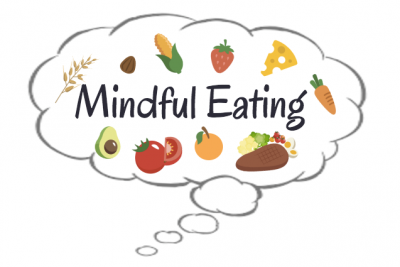Blog Material Written By: Corey Edmonds, MPH, Community Health Worker
In the world that we live in today, we are constantly tasked with being more efficient, taking less time to do everything, and to stretch ourselves thin to the point where we must multitask to be able to satisfy each and every one of our commitments. This lifestyle and accompanying mindset does not come without sacrifices or without taking other very valuable things hostage along the way. All too often, in pursuit of this false sense of perfection, we do damage to the one thing that really matters the most: our mental and physical well-being. There are a variety of ways in which we can neglect our wellbeing, but perhaps the most important of them all is our relationship with food. Relationship? With food? Most of us probably don’t even consider our interactions with food to be a relationship, but that is exactly what it is – a relationship that is most easily and recklessly abandoned.
You’ve probably heard of the term mindfulness, which according to Merriam-Webster, is defined as “the practice of maintaining a non-judgmental state of heightened or complete awareness of one’s thoughts, emotions, or experiences on a moment-to-moment basis.”1 You probably have not associated mindfulness with food consumption, however. While mindfulness is an ancient practice that has been around for hundreds of thousands of years, mindful eating is a relatively new phenomenon. According to Alyssa Pike, a Registered Dietician for foodinsight.org, “mindful eating is about listening to our physical sensations, like hunger, fullness, and satisfaction cues and taking time to notice our thoughts and emotions while eating so we can have a more enjoyable and healthful eating experience.”2 Moreover, mindful eating involves taking note of the smell, taste, and textures of food; reducing the speed at which we eat food to allow ourselves to focus on the food itself; responding to food choices and satiety cues without guilt; and maintaining an awareness of physical hunger, feelings of fullness, and satisfaction cues that allow us to decide what, when, and how much food to eat.
Mindful eating can be very beneficial in a number of ways. Included among these are creating a healthier mindset around food, helping us to have a more peaceful experience with food, reducing mindless eating or eating food when we are not really hungry, and allowing us to build a heightened sense of awareness while we are eating to foster a more positive overall relationship with food.2 Of course, becoming proficient at mindful eating is not something that happens overnight. Much practice and significant personal adjustment are necessary throughout the mastering of the process. The following infographic details some ways to practice mindful eating and some ways to avoid mindless eating.
Additionally, Dr. Lilian Cheung, a nutritionist, and lecturer at Harvard’s T.H. Chan School of Public Health outline 8 simple steps that one can take on their journey to mastering the art of mindful eating:
- Begin with your shopping list. Consider the health value of every item you add to your list and stick to it to avoid impulse buying when you’re shopping. Fill most of your cart in the produce section and avoid the center isles—which are heavy with processed foods—and the chips and candy at the check-out counter.
- Come to the table with an appetite– but not when ravenously hungry. If you skip meals, you may be so eager to get anything in your stomach that your first priority is filling the void instead of enjoying your food.
- Start with a small portion. It may be helpful to limit the size of your plate to nine inches or less.
- Appreciate your food. Pause for a minute or two before you begin eating to contemplate everything and everyone it took to bring the meal to your table. Silently express your gratitude for the opportunity to enjoy delicious food and the companions you’re enjoying it with.
- Bring all your senses to the meal. When you’re cooking, serving, and eating your food, be attentive to color, texture, aroma, and even the sounds different foods make as you prepare them. As you chew your food, try identifying all the ingredients, especially seasonings.
- Take small bites. It’s easier to taste food completely when your mouth isn’t full. Put down your utensil between bites.
- Chew thoroughly. Chew well until you can taste the essence of the food. (You may have to chew each mouthful 20 to 40 times, depending on the food.) You may be surprised at all the flavors that are released.
- East slowly. If you follow the advice above, you won’t bolt your food down. Devote at least five minutes to mindful eating before you chat with your tablemates.3
Some additional resources available to practice mindful eating are the following videos and exercises. Give them a try and see first-hand just how much eating mindfully can help you.
https://www.changetochill.org/wp-content/uploads/2014/05/Mindful-Eating-Exercise.pdf
https://www.jmu.edu/counselingctr/files/Mindful%20eating.pdf

